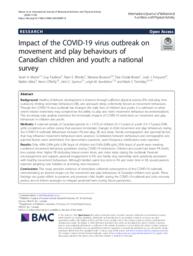Brussoni, Mariana
Person Preferred Name
Mariana Brussoni
Related Works
Content type
Digital Document
Abstract
This paper explores patterns of increased/ decreased physical activity, sedentary and sleep behaviours among Canadian children and youth aged 5-17 years during the COVID-19 pandemic, and examines how these changes are associated with the built environment near residential locations. A cluster analysis identified two groups who were primarily distinguished by the changes in outdoor activities. Compliance to 24-hour movement guidelines was low among both groups. For children, houses (versus apartments) was correlated with increased outdoor activities; proximity to major roads was a barrier. For youth, low dwelling density, and access to parks in high-density neighbourhoods, increased the odds of increased outdoor activities during the pandemic. Our findings can inform future urban and health crisis planning practices by providing new insights into the desirable public health messaging and characteristics of healthy and resilient communities. [ABSTRACT FROM AUTHOR]
Origin Information
Content type
Digital Document
Abstract
Background: Healthy childhood development is fostered through sufficient physical activity (PA; including time outdoors), limiting sedentary behaviours (SB), and adequate sleep; collectively known as movement behaviours. Though the COVID-19 virus outbreak has changed the daily lives of children and youth, it is unknown to what extent related restrictions may compromise the ability to play and meet movement behaviour recommendations. This secondary data analysis examined the immediate impacts of COVID-19 restrictions on movement and play behaviours in children and youth.<p>
<p>Methods: A national sample of Canadian parents (n = 1472) of children (5–11 years) or youth (12–17 years) (54% girls) completed an online survey that assessed immediate changes in child movement and play behaviours during the COVID-19 outbreak. Behaviours included PA and play, SB, and sleep. Family demographics and parental factors that may influence movement behaviours were assessed. Correlations between behaviours and demographic and parental factors were determined. For open-ended questions, word frequency distributions were reported.<p>
<p>
Results: Only 4.8% (2.8% girls, 6.5% boys) of children and 0.6% (0.8% girls, 0.5% boys) of youth were meeting combined movement behaviour guidelines during COVID-19 restrictions. Children and youth had lower PA levels, less outside time, higher SB (including leisure screen time), and more sleep during the outbreak. Parental encouragement and support, parental engagement in PA, and family dog ownership were positively associated with healthy movement behaviours. Although families spent less time in PA and more time in SB, several parents reported adopting new hobbies or accessing new resources.<p>
<p>
Conclusions: This study provides evidence of immediate collateral consequences of the COVID-19 outbreak, demonstrating an adverse impact on the movement and play behaviours of Canadian children and youth. These findings can guide efforts to preserve and promote child health during the COVID-19 outbreak and crisis recovery period, and to inform strategies to mitigate potential harm during future pandemics.
Origin Information
Content type
Digital Document
Abstract
The COVID-19 outbreak and related public health guidelines have changed the daily lives of Canadians and restricted opportunities for healthy movement behaviours for children. The purpose of this study was to explore how parents experienced the pandemic-related restrictions and how they impacted their children’s movement behaviours. Methods: Twenty-nine semi-structured one-on-one interviews were conducted (June–July 2020) with parents of children (5–11 years old) in Ontario and British Columbia. Interviews lasted between 24–104 min, were audio-recorded, transcribed verbatim, and thematically analyzed. Results: Findings emphasized various individual (e.g., motivation), interpersonal (e.g., parent work schedule), built (e.g., closure of parks) and natural environment (e.g., weather) factors related to children’s movement behaviours. The findings highlighted the loss of structured activities and destinations for children’s physical activity, and restricted opportunities for outdoor play exacerbated by shrinking childhood independent mobility. Conclusion: Families are adapting to many pandemic-related challenges including adhering to public health restrictions, parents juggling multiple roles, conducting work and school from home, as well as exacerbating factors like weather. It will be important to continue to encourage outdoor time, support policies and practice that facilitate independent mobility, and develop centralized resources that help families in the maintenance of healthy movement behaviours.
Origin Information



